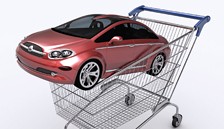Despite levels of new car sales peaking in 2003, it wasn’t until the middle of last year that new registrations began their rapid decline (see chart). So what happened?
Pre, self or forced, whichever prefix you choose to use, the reasons for self-registration are many, but all contributed to the over-supply of new cars into the UK.
In a recession, when big-ticket purchases are often the first casualties, this over-supply was unsustainable, part-icularly with the decline in sterling exchange rate affecting oversees manufacturers’ returns.
This shift to a more realistic level of new car sales has undoubtedly been a contributory factor in the remarkable rise in used values seen this year.
As new car sales fell, buyers looking for a more cost-effective means of changing car meant more dealers found themselves chasing the same used stock.
So, although conversion rates are not as high as the near 100% recorded in March, and despite a little more selectivity returning to trade buying, there are still more buyers and not enough used stock.
So what has the actual impact been on used values? Used residuals have increased significantly: 2006 06 values in some sectors have returned to last September’s levels. 4x4 values have recovered the most; increasing an average £1,400 since January this year, to return to September’s level.
However, a truer picture emerges when comparing average three-year-old values in July 09 with three-year-old values in July 08.
That shows the city car, supermini and mini MPV are still the star used value performers.
Taking into account that an expectation of 5% depreciation for lifecycle is the norm, supermini’s 7.1% increase shows that underlying values have increased significantly.
The question is how far can values continue to rise? Well, most pricing models will tend to a limit, but if the current situation continues there may still be further increases to come.













Login to comment
Comments
No comments have been made yet.